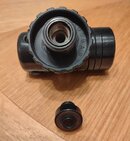Has anyone had issues with the Hog D1X first stage DIN locking screw (part #2) undoing itself?
I'm not sure what I'm doing wrong, but it sometimes just unscrews itself after being pressurised. I can't see anything wrong with the part or the o-ring on either side. It almost seems like when it's pressurised, if the first stage moves slightly, the DIN o-ring creates enough friction to unscrew itself? It only falls out after I depressurise it. It doesn't happen often, but it's happened like 2-3 times too often.
I have torqued it as per the service manual, to 125 inch pounds/14nm.
I'm not sure what I'm doing wrong, but it sometimes just unscrews itself after being pressurised. I can't see anything wrong with the part or the o-ring on either side. It almost seems like when it's pressurised, if the first stage moves slightly, the DIN o-ring creates enough friction to unscrew itself? It only falls out after I depressurise it. It doesn't happen often, but it's happened like 2-3 times too often.
I have torqued it as per the service manual, to 125 inch pounds/14nm.




